Britain’s Covid cases may not be falling as quickly as official data suggests, symptom-tracking experts claimed today.
King’s College London scientists estimated slightly more than 60,000 people were getting infected each day in the week ending July 24, the latest available. This was barely different to the previous seven-day spell.
Experts behind the study said their results may differ from the official tally because the swabbing drive was now ‘testing the wrong people’, leading to many infections being missed.
They pointed to their own data which showed vaccines had mostly turned Covid into a ‘bad cold’ — with double-vaccinated Brits who catch the virus more likely to suffer a headache, runny nose, sneezing and a sore throat than the ‘classic’ three symptoms.
Officials have repeatedly refused to expand the Covid symptoms list to include more warning signs than a high temperature, new continuous cough and loss of taste and smell. This is despite more than 70 per cent of Britons being fully-jabbed.
Professor Tim Spector, who leads the study with health data company ZOE, said the figures showed Covid cases ‘have stopped rising for the last week and are holding steady around the 60,000 mark’.
‘This is in stark contrast to the rapid decline in cases recorded by the Government’s official confirmed cases data,’ he said. ‘The drop is much faster than we’ve seen in previous waves, even after full national lockdowns, leaving the accuracy of the official tally in doubt.’
The epidemiologist added: ‘The UK is still testing more people than virtually any other country, although numbers have recently dropped, so it could be that we are now testing the wrong people.
‘There is still a very strict and limited symptom list in place, and we’ve been calling on the Government for months to expand the list to include cold-like symptoms which are currently the most common symptoms we are seeing in confirmed Covid cases.’
Official figures show Britain has recorded a week-on-week drop in Covid cases every day for the past week, with the number of positive tests dipping by 37 per cent yesterday to 27,734.
The promising figures prompted some experts to say Britain may now be ‘very close’ to achieving herd immunity against Covid. But others claim reaching herd immunity — when enough of the population has some protection versus the virus that it struggles to spread — against Covid is near impossible.
Separate Test and Trace figures today showed Covid cases rose by almost a third in the week to July 21, the latest available, when almost 308,000 were spotted. But the figures lag behind the official tally by a week, meaning they won’t show a drop yet.
The system continued to buckle under the strain of the third wave after it failed to reach 14.8 per cent of Covid positive people in the latest week and ask them for close contacts. This was the highest proportion since October last year, when the second wave started to gather steam.
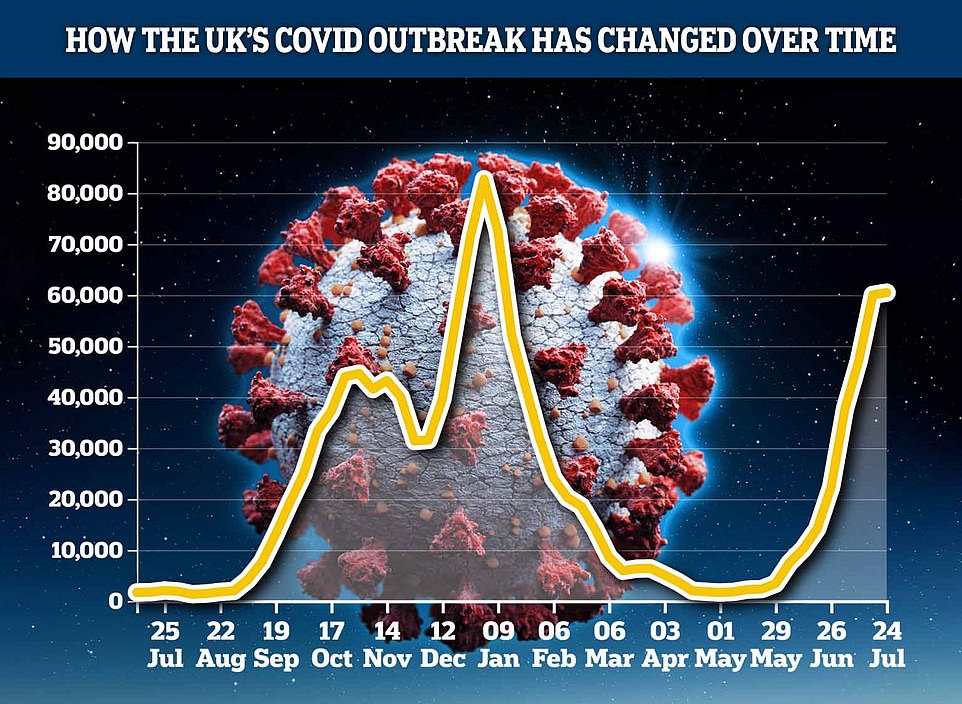
The Covid symptom study today showed there were just over 60,000 people catching the virus every day in the week to July 24, the latest available. This was a slight rise on the previous week when 60,000 people were getting infected a day. Experts behind the study said their figures differed from the national charts because Britain may now be testing the wrong people
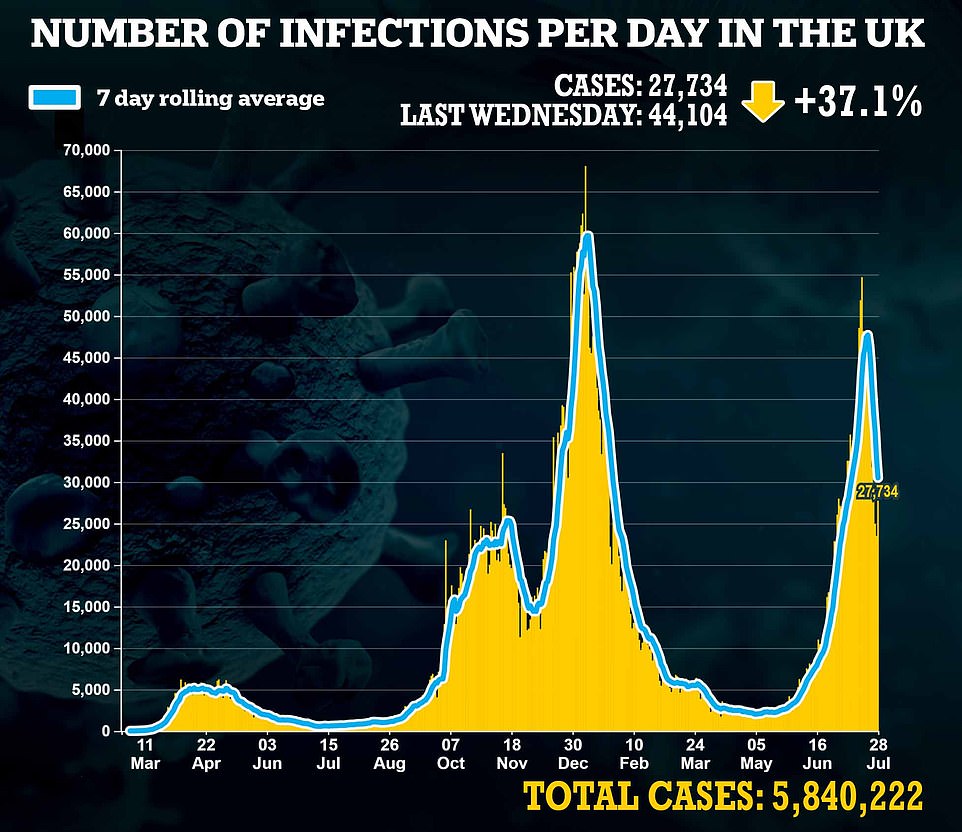
The symptom-study’s results differ from the Department of Health’s official tally, which has shown a drop in Covid cases week-on-week for the past seven days. Yesterday they fell by 37 per cent from the previous week to 27,734 infections
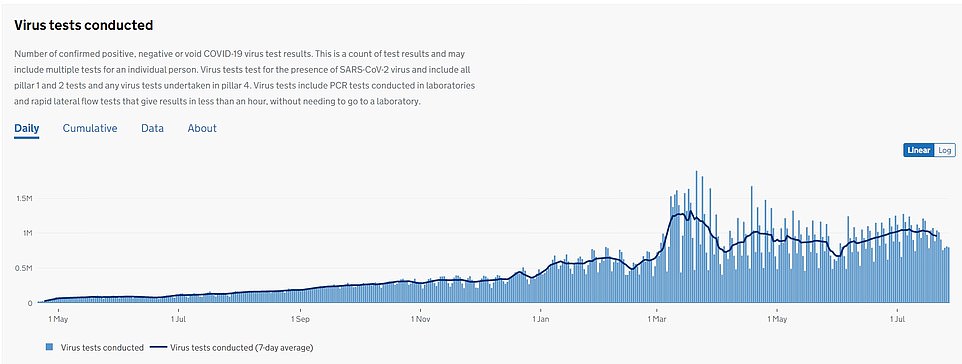
Official data shows the number of Covid tests carried out has dropped slightly over recent weeks. Experts say this is likely due to the school holidays, meaning hundreds of thousands of children no longer have to test themselves twice a week for Covid. The average number of tests carried out dropped almost eight per cent in the week to July 21, the latest available, after 960,000 people were swabbed for the virus a day on average

The symptom study found the majority of new infections were among people who had not been vaccinated (36,102 new cases a day — blue line). They said more people who were double-vaccinated were catching the virus every day (14,110 – red line) than partially vaccinated people (10,268 – green line). They said this was because far more Britons have been double-vaccinated than have received one dose. The graph is shown as the infection rate per 100,000 people in each group. This has led to the single-vaccinated cases appearing to be higher than the double-vaccinated cases because far fewer people have received one dose, as have received both doses
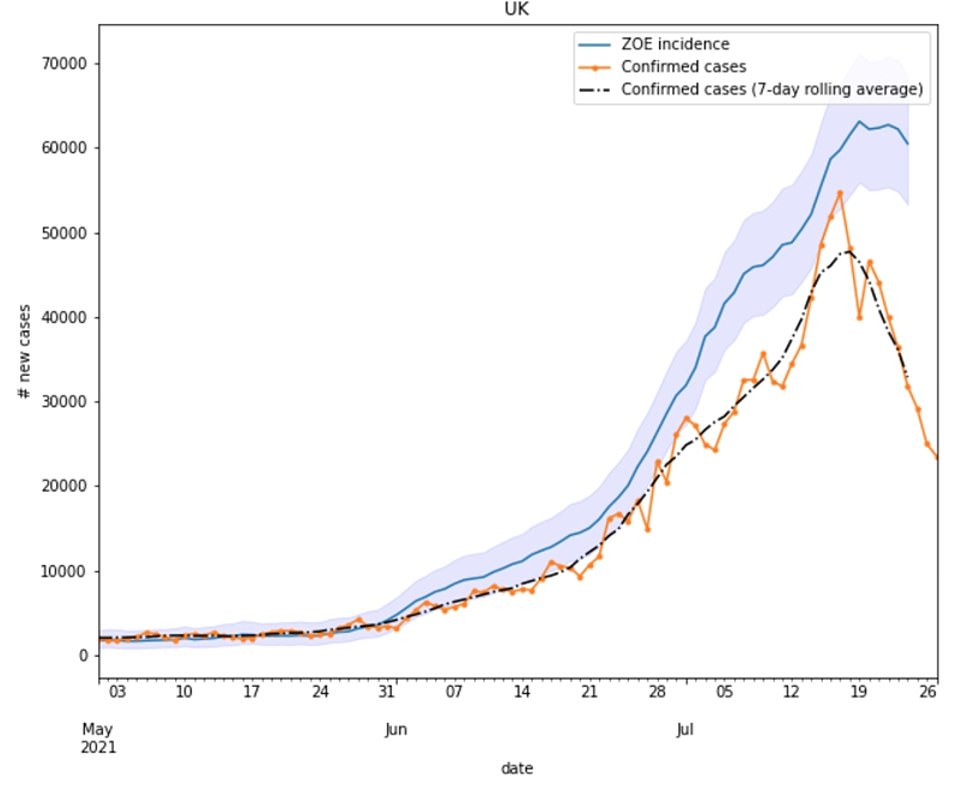
Figures from health data company ZOE show Covid cases have plateaued in recent days (blue). This is in start contrast to daily figures from the Department of Health (orange) and their average (black) which suggest there has been a sharp fall in cases. Experts behind the app said the Department of Health may be picking up a fall because it was now testing the wrong people


Professor Tim Spector, who leads the app, said their results may differ from the official tally because Britain is now testing ‘the wrong people’. He pointed to data from his study showing double-vaccinated people who catch Covid now suffer it as a ‘bad cold’, and are less likely to get the ‘classic’ symptoms of a high temperature, new continuous cough and loss of taste and smell. Officials have refused to expand the Government’s list of symptoms (Right: Boris Johnson yesterday)
The ZOE Covid symptom-study relies on daily reports from more than a million Britons to track the spread of the virus across the country.
It asks participants to report whether they are feeling unwell, their symptoms and whether they have received a positive test for the virus.
In the latest week it estimated 60,480 people were catching Covid in the UK every day. In the previous seven-day spell it estimated 60,019 were being infected daily.
The majority of cases were assumed to be among Britons that were still yet to receive a single dose of a vaccine, with 36,102 new infections per day.
Top US forecaster says ‘Professor Lockdown’ Neil Ferguson was ‘overconfident’ in his prediction of 100,000 cases a day
Renowned US forecaster Nate Silver has slammed ‘Professor Lockdown’s’ prediction that Covid cases would rise to 100,000 a day in the UK.
Mr Silver — who correctly predicted the outcome of all 50 states in the 2012 election but ‘screwed up’ on Donald Trump’s victory in 2016 — said there were too many unknowns in the pandemic for anyone to confidently assert anything.
Professor Neil Ferguson, of Imperial College, had predicted that the third wave could lead to a huge surge in infections, with cases spiralling next month.
But after the recent downturn in cases, Professor Ferguson revised his prediction and said he was ‘positive’ the worst of Covid could be over by October.
Writing on Twitter, Mr Silver said: ‘Covid cases have fallen to 33,000 per day (7-day average) since Neil Ferguson, perhaps the UK’s most prominent epidemiologist, said it was ‘almost inevitable’ that cases would hit 100,000 a day.
‘I don’t care that the prediction is wrong, I’m sure this stuff is hard to predict.
‘It’s that he’s consistently so overconfident. Now he says he’s ‘positive’ the pandemic will be over by October.
‘Well, probably. But there are downside risks: new variants, waning immunity, etc.’
Other forecasters agreed, with political scientists Philip Tetlock — author of one of Dominic Cummings’s favourite books Superforecasting — suggesting Professor Ferguson was ‘overconfident’.
He said: ‘Expect even top forecasters to make lots of mistakes. When smart forecasters are consistently overconfident, start suspecting they’re not playing a pure-accuracy game (e.g. publicity or policy-advocacy games).’
Professor Ferguson had said the drop in infections appeared to be ‘real’ and the R number could be slightly below one – although he cautioned that the situation is still very uncertain and there might be more spikes.
He suggested the dip was down to the end of the Euros football tournament and warmer weather meaning people were mixing indoor less.
While he said there could be ‘uncertainty’ heading into the autumn, he stressed that the calculations had ‘fundamentally’ changed due to vaccines.
Advertisement
Among vaccinated Britons the study predicted there were more daily infections among people who have received both doses (14,110 cases a day) than one dose (10,268).
This does not mean vaccines do not work, and merely reflects the fact that most of the country has now received both doses, experts say.
Official data shows 37.6million Britons — or 71.1 per cent of adults — have got both doses of the vaccine, while 9million — 17.2 per cent — have only received one dose.
Professor Spector said: ‘The ZOE app figures are calculated using symptom data and logged test results, whereas confirmed cases (from the Department of Health) rely solely on test data.
‘All Covid surveillance surveys are showing higher rates than confirmed cases and all differ slightly in their methodologies, and at times like these, we should be looking across all the sources to try to understand what is happening.’
He added that the strict Covid symptoms list was likely stopping people coming forward to get tested in the early stages of an infection, leading to many cases being missed.
‘If we got into line with other countries (by recognising more symptoms), we could pick up cases that are currently going undetected,’ he said.
The ZOE Covid symptom study was one of the first studies to spot loss of taste and smell as a symptom of the virus, and successfully lobbied ministers to have it added to the official warning signs list.
Since then it has repeatedly called for the symptom list to be expanded to ensure more infections are caught in the early stages, helping to curb the spread of the virus.
They point to other countries that have recognised far more symptoms of an infection with the virus.
For example, authorities in the US have identified more than 20 symptoms as a possible sign of a Covid infection.
Guidance says Britons should only get tested for Covid if they are suffering from the three key warning signs, or if they are told to get swabbed by Test and Trace.
It comes as official data from the Department of Health yesterday showed cases had dropped week-on-week for the past seven days.
Experts say part of the drop may be down to the summer holidays, meaning fewer tests are done because pupils no longer have to test themselves twice a week for the virus.
But the positivity rate — the proportion of swabs that detect the virus — has also dipped in another promising sign there may be fewer Covid infections in the country than there were last week.
The figures yesterday prompted scientists to suggest Britain may be reaching the ‘holy grail’ of herd immunity — when the virus stops spreading in the community because so many people have antibodies to fight it off.
University College London experts say around 93 per cent of people will need some form of immunity to Covid in order to stop the disease spreading.
In their most recent estimates, they said around 87 per cent of people now have antibodies to fight the virus off.
They had previously suggested a lower proportion of people would need antibodies to stop the disease spreading in the country, but the emergence of the more transmissible Indian ‘Delta’ variant changed the goalposts.
Dr David Matthews, a virologist from the University of Bristol, told The Telegraph: ‘In terms of herd immunity – by which we mean the virus has managed to reach everybody and therefore most people will have a level of immune memory – I suspect we’re very close to it.
‘Assuming nothing truly spectacularly leftfield happens then this pandemic is pretty much over for the UK. I suspect we will not see a major surge this winter, or any serious levels of fatalities.
‘The more we close the gap on the last 10 per cent who haven’t had the vaccine the better we will be. Everyone will eventually meet the virus and it is far better to do so vaccinated.’
Downing Street has played down suggestions that the end of Britain being in a pandemic state was in sight. ‘No one here is declaring mission accomplished,’ a source said.
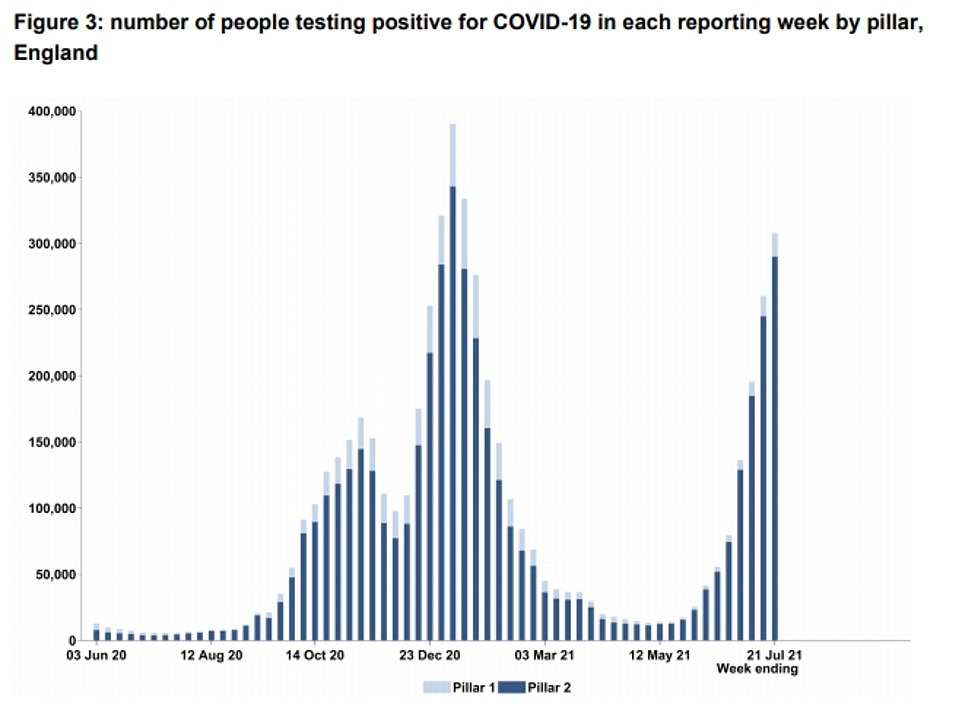
Separate data from Test and Trace showed Covid cases rose by almost a third in the week to July 21, after 295,000 people tested positive. The system lags a week behind the official tally, meaning it is not yet expected to show a fall in cases
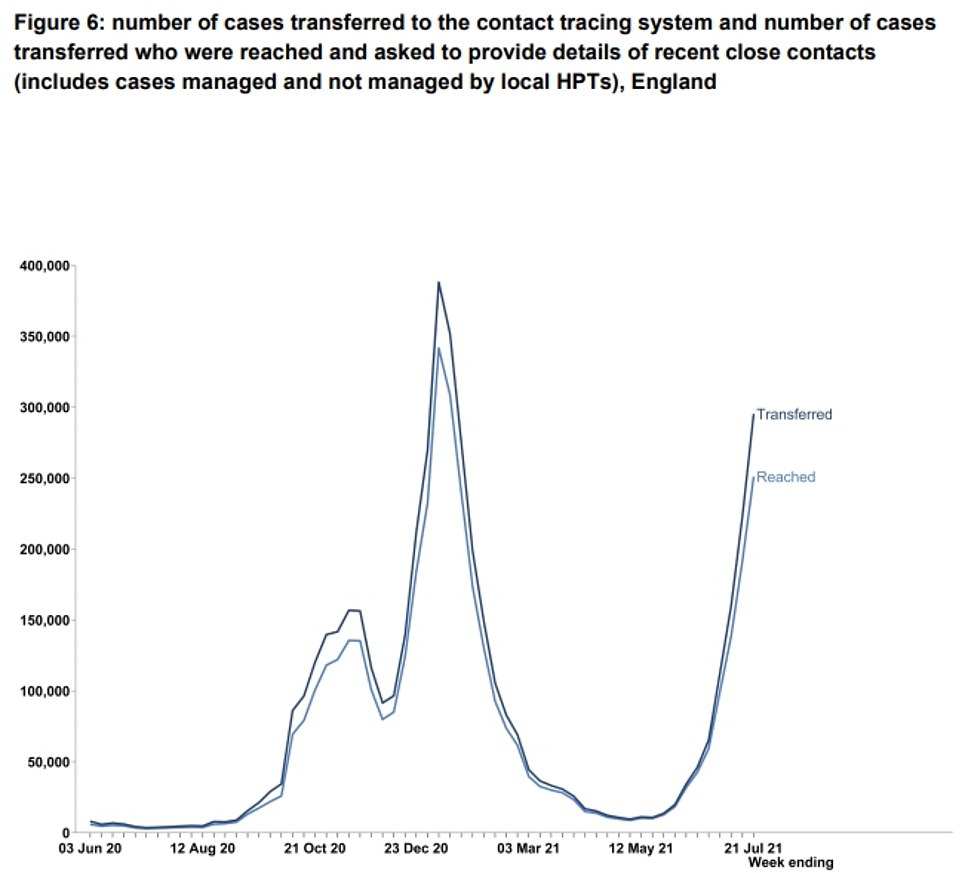
There were also signs the system is already buckling under the pressure. Data showed it failed to reach 14.8 per cent of Covid positive people in the latest week, the highest since October last year when the second wave was gathering steam. A Covid-infected person is marked as not reached when they do not respond to texts, calls and emails telling them they have tested positive for the virus and need to self-isolate for ten days

This graph shows the daily percentage change in the seven-day Covid infection rate per 100,000 people split by age group. It reveals infections are falling fastest among young adults in their 20s (orange) by 15 per cent. Cases among 20 to 24 year olds fell from 1,091 per 100,000 on average on July 21, to 922.7 per 100,000 on July 22. But infections are dropping in all age groups. Among those in their early 80s (pale orange) they fell by 3.2 per cent from 74.9 per 100,000 on July 21 to 72.5 per 100,000 on July 22
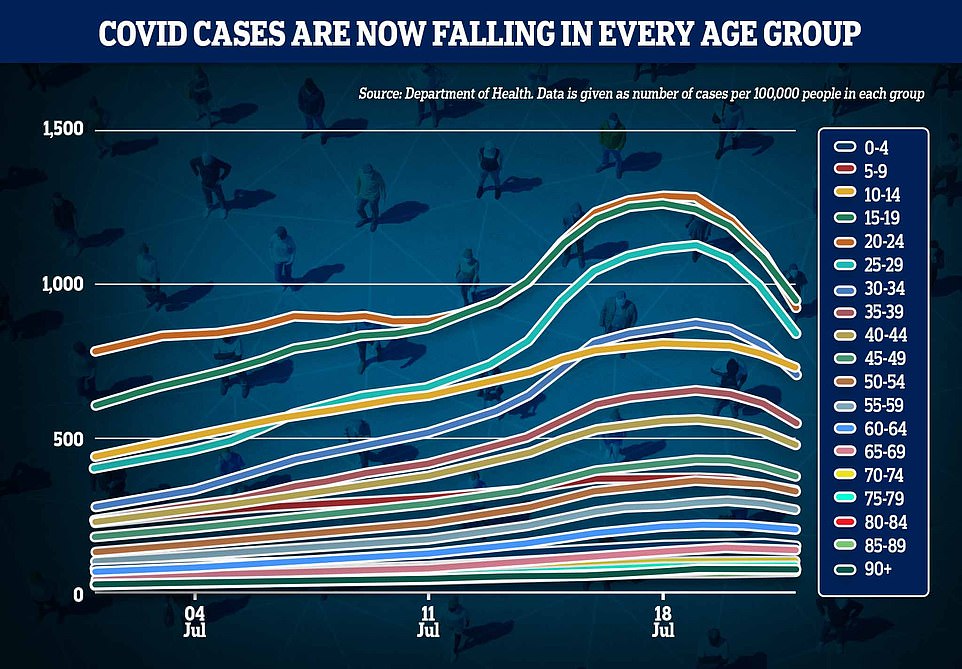
This graph shows the seven-day Covid infection rate by age group since the start of June. It reveals cases are dipping in all age groups including older adults. It is difficult to see some lines bending downwards on the graph because of the different infection rates between age groups. Those aged 15 to 19 had the most cases (green) followed by 20 to 24 year olds (orange)
Record 1.5MILLION self-isolation alerts were sent last week, official data shows
A record 1.5million people were asked to self-isolate by NHS Test and Trace last week, official data shows as England’s ‘pingdemic’ chaos continues to rage on.
NHS figures show nearly 690,000 alerts were given out by the app last week, the highest number since it was introduced.
A further 536,000 people were reached by call handlers, while 308,000 were asked to isolate after testing positive for the virus.
In total, more than 3.9million people have been told to isolate since the start of July, the data shows.
However, a single person may be identified by the app and call handlers before going on to test positive themselves — or be asked to isolate multiple times in the same month — so the true number of individuals isolating is likely to be lower.

A record 1.5million people were asked to self-isolate by NHS Test and Trace last week, official data shows
The damning statistics come as ministers continue to face heavy criticism for refusing to ditch isolation requirements despite lifting restrictions on ‘Freedom Day’.
Communities Secretary Robert Jenrick today acknowledged the system is ‘frustrating’ but continued to urge people to isolate if they are pinged.
One of the Government’s top scientific advisors yesterday said he advised ministers to adopt a ‘test and release’ strategy as early as January, but Boris Johnson has so far refused to budge on the August 16 date for scrapping self-isolation for the double-jabbed.
And millions of workers across the country have been left unable to do their jobs because they are forced to isolate — despite not testing positive for the virus themselves.
Industry bosses have slammed the current system for forcing business to shut up shop because of the loss of workforce.
Advertisement
Separate Test and Trace data showed Covid cases rose by almost a third in the week to July 21, the latest available, from 260,208 to 307,758.
They lag by about a week behind the official tally.
And there are already signs the £37billion system is buckling under the pressure as it struggles to reach people who have tested positive for the virus, increasing the risk of someone unwittingly spreading the disease.
There may also be hints in the data that Britons are turning away from Test and Trace amid the ‘pingdemic’, which has left supermarket shelves empty and bins uncollected because workers were forced into self-isolation after they were found to have been near a Covid case.
Data showed 14.8 per cent of people who tested positive for the virus were not reached in the latest week, or almost 44,000 Covid-infected individuals.
Test and Trace marks someone down as ‘not reached’ if they do not respond to texts, phone calls and emails from the service telling them they have tested positive for the virus and need to self-isolate.
A further 23 per cent of Covid-positive cases who were reached were marked as unable to provide details of their close contacts, the highest proportion since February when the second wave was dying down.
Boris Johnson yesterday confirmed that crippling self-isolation rules for the double-vaccinated would be ‘nailed on’ until August 16, amid ‘pingdemic’ chaos forcing hundreds of thousands to quarantine.
The Prime Minister added that the jab rollout should allow for a ‘very, very strong’ economic recovery in the second half of this year. It came after a senior minister said yesterday the vaccine success meant Covid’s grip on the UK was ‘all over bar the shouting’.
The promising drop in Covid cases yesterday led some ministers to say Britain may soon reach ‘herd immunity’. Figures also showed seven-day averages for Covid cases were now dipping in all age groups.
Professor Karl Friston, one of the modellers at UCL, said: ‘We are currently close to – but not at – herd immunity, according to real-time estimates.
‘The herd immunity threshold is currently about 93 per cent but our population immunity is only 87 per cent.
‘But as witnessed by the recent decline in notification rates, we do not need to reach a herd immunity threshold to bring the effective R-number below one and, in principle, suppress viral transmission.’
Professor Friston and colleagues were behind claims that Britain was days away from reaching herd immunity back in the spring, before the Indian variant took hold.
Highly contagious diseases — such as measles — require a greater proportion of the population to have immunity against them to stop their spread.
Scientists criticised the UCL modelling at the time, with one warning that it has a ‘history of making over-confident and over-optimistic predictions’.
Other experts say the concept of herd immunity for coronaviruses is a ‘myth’ because of the short immunity post-infection. For this reason, academics believe the virus will eventually become endemic and circulate in humans for generations.
But they do accept that the concept of population immunity plays an important role in the trajectory of the pandemic, making the disease milder over time.


Boris Johnson (pictured at a police memorial today) has said it is still ‘too early’ to tell whether the fall in Covid cases is permanent. SAGE expert Professor Mike Tildesley warned the impact of Freedom Day is yet to be seen in the data
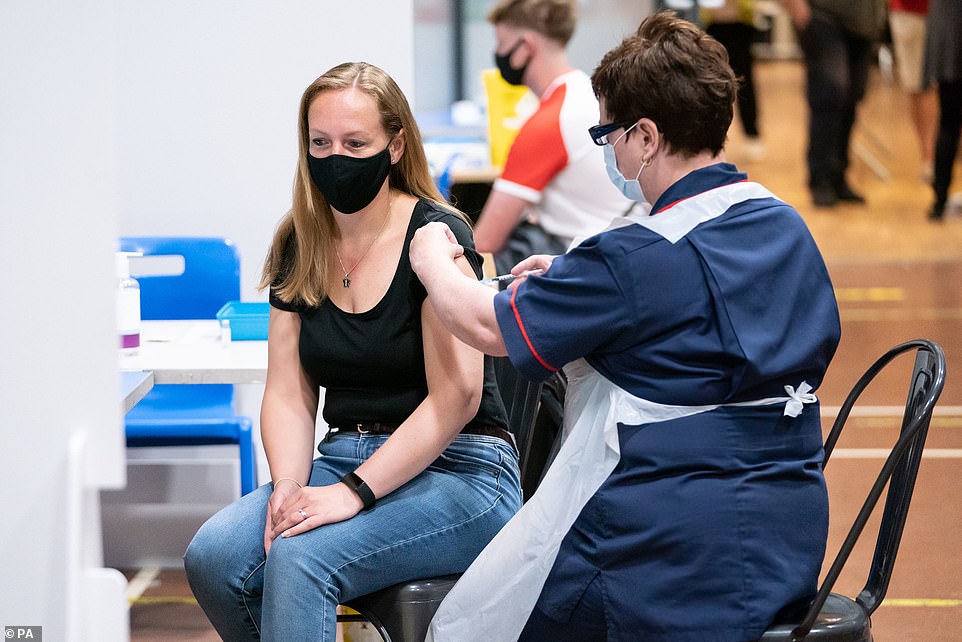
Department of Health data today revealed that infection rates are now ticking downwards in every age group in England. Pictured: Practice nurse Nicola Morris vaccinates Lisa Hanson with the Pfizer vaccine in Doncaster
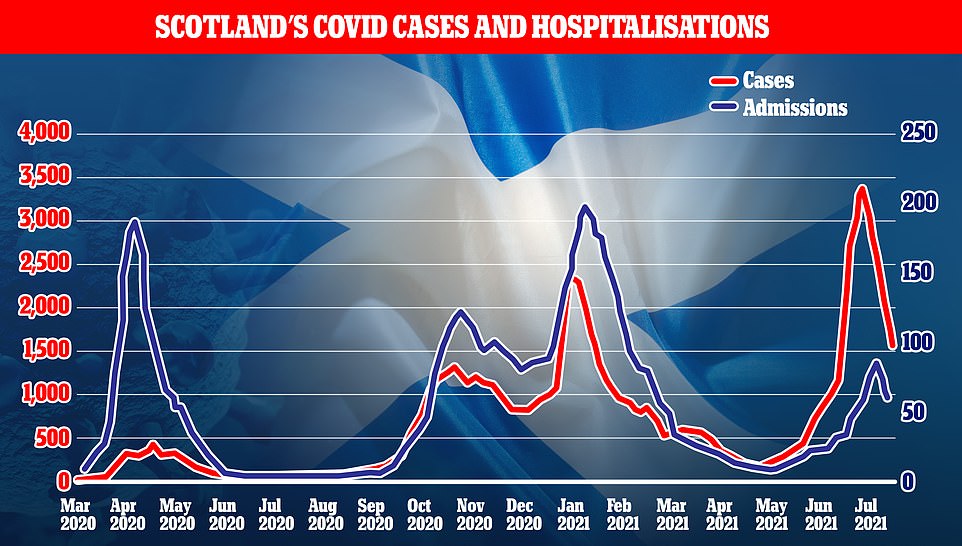
Scotland’s Covid hospital admissions (blue) have begun to fall around 10 days after cases fell, data revealed, after cases also dipped (red). Experts say it is ‘reasonable’ to expect the same to occur in England, with the nation’s downturn in infections delayed compared to Scotland because of Euro 2020

England has seen Covid infections (red) fall for the last seven days but has yet to see the trend in its hospital admissions, which usually follow by around 10 days. Professor Paul Hunter, an infectious disease expert at the University of East Anglia, told MailOnline while England may not see admissions (blue) fall on the ‘exact same day’ after their Euros exit as Scotland did, hospitalisations have already begun slowing
Covid cases not reached through Test and Trace at nine-month high
The proportion of people who test positive for Covid but who are not being reached by the Test and Trace system has reached a nine-month high, new figures show.
Some 14.8per cent of people transferred to Test and Trace in England in the week to July 21 were not reached, meaning they were not able to provide details of recent close contacts.
This is the highest proportion since the week to October 14 2020, early in the second wave of coronavirus.
The figures, which have been published by the Department of Health and Social Care, show that 295,315 people were transferred to Test and Trace in the most recent week – the highest number since mid-January.
But while 251,190 of these people were reached and asked to provide details of close contacts, 43,778 were not reached.
A further 347 people did not provide communication details.
Anybody in England who tests positive for Covid, either through a rapid (LFD) test or a PCR test processed in a laboratory, is transferred to Test and Trace so their contacts can be identified and alerted.
With around one in seven people not being reached, it is likely that tens of thousands of other people are not being contacted to let them know they need to self-isolate.
More than half a million (536,338) close contacts were reached and asked to self-isolate in the week to July 21 – again, the highest number since mid-January.
Yet of all the close contacts successfully identified in the latest week, around one in 10 were still not reached.
The latest figures suggest the Test and Trace system is facing pressures similar to those seen during the second wave of the virus last winter.
Just under two thirds (63.7 per cent) of people who were tested for Covid in England in the week ending July 21 at a regional site, local site or mobile testing unit – a so-called ‘in-person’ test – received their result within 24 hours.
This is down slightly from 64.7 per cent in the previous week, and is the third time since mid-January that the percentage has been below two thirds.
Prime Minister Boris Johnson had pledged that, by the end of June 2020, the results of all in-person tests would be back within 24 hours.
Advertisement
It came as experts said the downturn in cases was a ‘very good’ sign because it added to mounting evidence that the third wave was in retreat. They cautioned, however, that more data was needed before they could be certain the drop was permanent, and cases would not tick up again after Freedom Day.
In another glimmer of hope, researchers also believe England’s hospitalisations will start to fall by the end of the week — mirroring a similar trend as seen in Scotland.
Figures show admission rates are already falling in Scotland, where cases began to drop around eight days after the country’s football team were knocked out of Euro 2020. Likewise, England’s drop in Covid infections began on July 19 — eight days after the Three Lions lost on penalties in an historic final against Italy.
Several members of SAGE have said a fall in Covid admissions would mark the beginning of the end of the third wave. But the number of infected patients needing medical care is still rising — albeit at a slower rate than it was.
But SAGE modeller Professor Mike Tildesley today said the pandemic isn’t all over ‘quite yet’ and warned the effects of Freedom Day are still yet to be seen in the data.
Boris Johnson said it was ‘too early’ to draw conclusions about the fall in the number of people testing positive for the virus.
Scientists say temporary factors like schools closing, last week’s hot weather and people not wanting to get tested before going on holiday may be behind England’s declining cases.
Others believe one of the major reasons for the drop — especially in younger people — is because groups are no longer meeting up indoors to watch the Euros.
Experts suggest the downturn in older adults could also be linked to warmer weather, allowing people to spend more time outdoors where the virus finds it harder to spread.
But the vaccines roll-out is also bound to have an impact, after more than 70 per cent of adults have received both doses including the vast majority of the over-70s.
Professor Paul Hunter, an infectious disease expert at the University of East Anglia, said cases in age groups may already be even lower because the latest figures are ‘about a week out of date’.
He hinted infections were dropping slower in older people because they tend to catch the virus from younger age groups. There will be ‘some lag’ between the different groups, he said.
Dr Jonathan Stoye, a virologist at the Francis Crick Institute, said the drop in Covid cases in all age groups was ‘very good’.
He told MailOnline: ‘But the key thing will be to wait until Friday when we will get the next round of results from the ONS (Britain’s largest Covid surveillance study).
‘One would predict it may be less sensitive to changes in the populations being tested, for example those resulting from school closures, than the Department of Health figures.
‘If the two measures are going in the same direction we would seem to be in a good place… unless, of course, the unlocking of July 19 causes a reversal.’
Department of Health data showed Covid cases were falling fastest among adults in their twenties last week, down by 15 per cent for the week ending July 22 compared to the day before.
But among older adults the decline was more gradual, suggesting cases were only just starting to drop in the age group. Infection rates dropped by just one per cent in adults in their late 80s.
The figures — provided by the Department of Health — are based on the rolling seven-day infection rate for age groups.
It is based on data from the actual day positive Covid tests were taken, as opposed to when they were recorded. For this reason, the most up-to-date statistics are seven days old.
The drop in cases was revealed by comparing the average infections between July 21 and July 22, the latest dates available.
Comparing infection rates to the week before showed cases are falling among young people, but were higher in over-45s than they were a week ago.
Experts said this was to be expected because cases had only recently started falling in older age groups.
Across England adults in their early twenties had the highest infection rate (947 cases in the last seven days per 100,000 people), followed by adults in their late twenties (923) and early thirties (842).
For comparison, cases were lowest in adults in their late 80s (68), followed by adults in their early eighties (73), and over-90s (75).
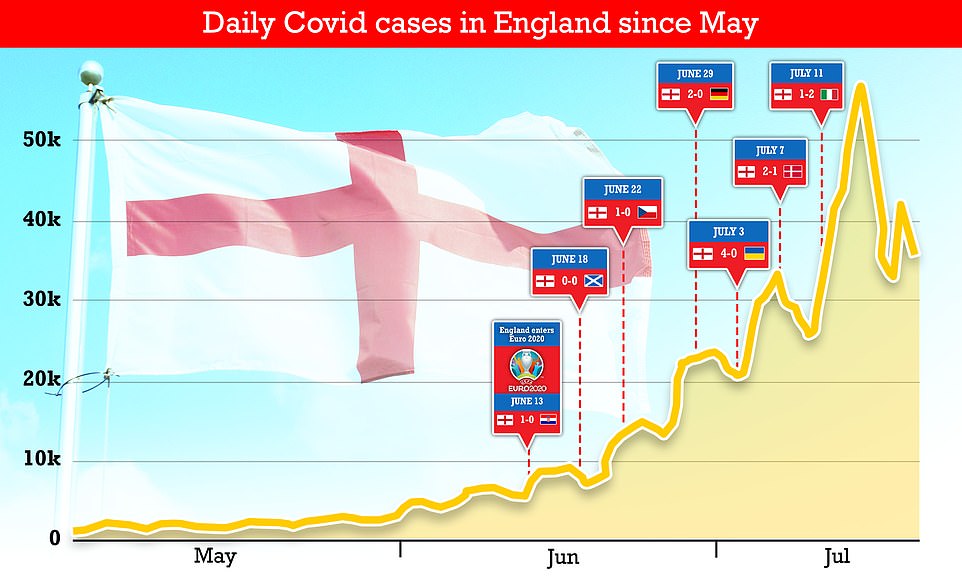
Scientists say the drop off in Covid cases could be caused by schools closing, recent warm weather and Euro 2020 boosting immunity in young people. Graph shows: The drop off in infections in England after the end of Euro 2020
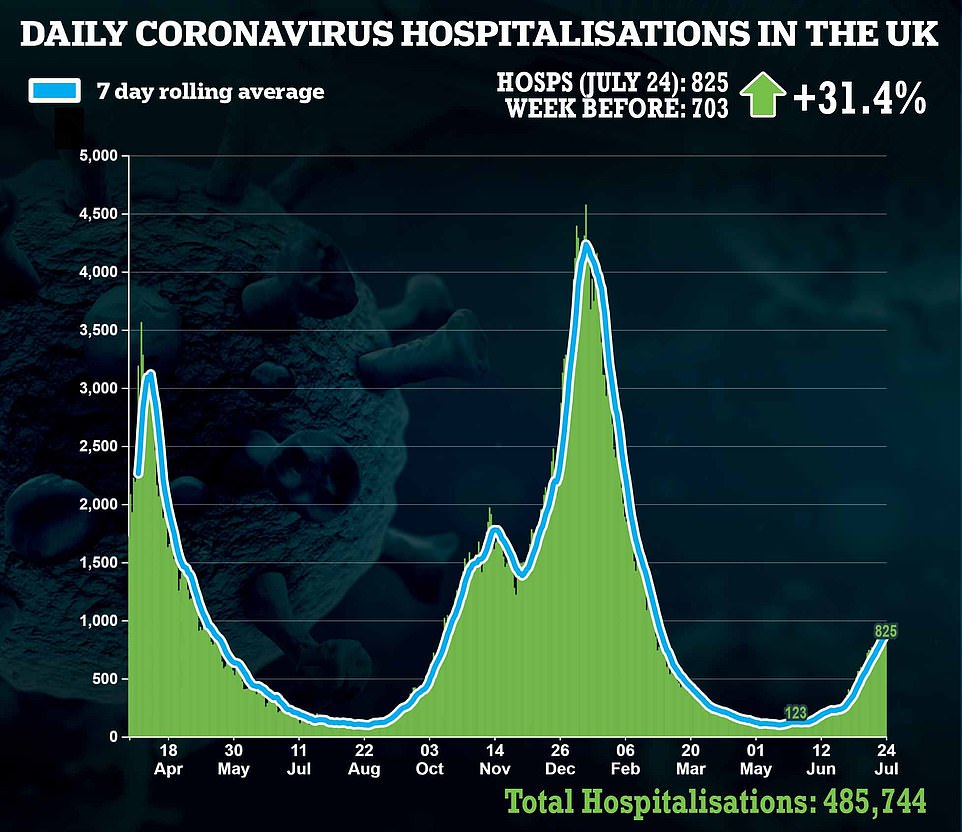
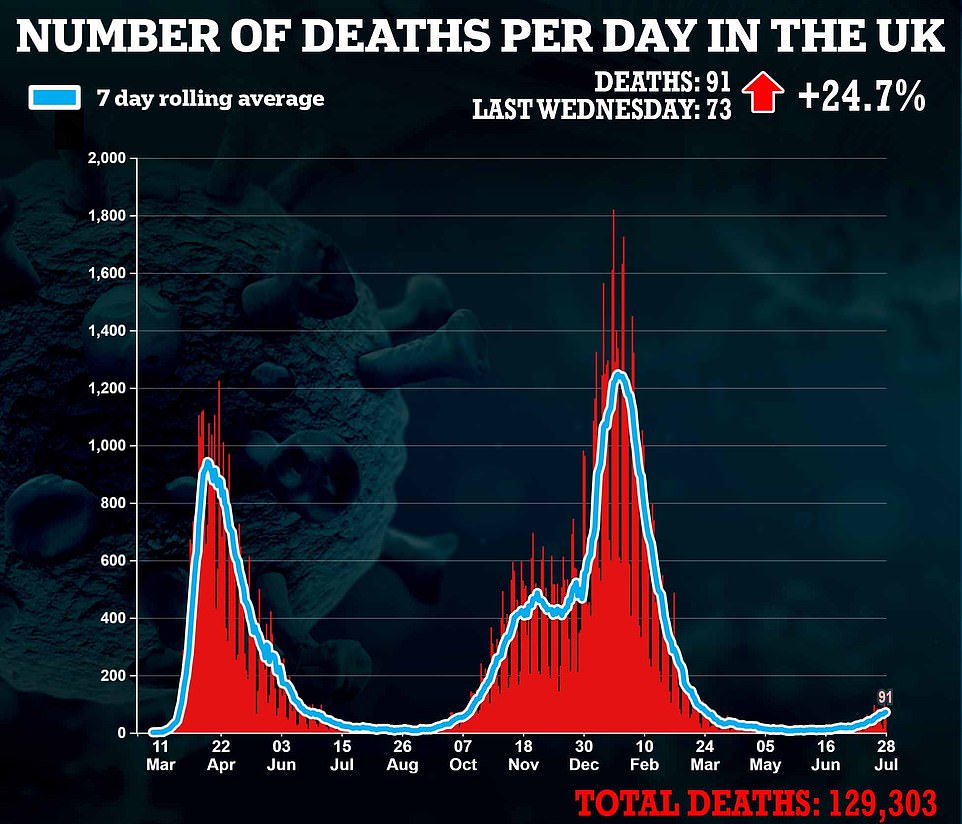
Quarantine rules to be dropped for fully-vaccinated travellers
Fully-vaccinated travellers from the EU and US are set to be spared quarantine after ministers signed off an exemption today.
The powerful ‘Covid O’ group is understood to have agreed that the self-isolation requirements can be dropped for some of the UK’s major trading partners.
Ex-pats who have received jabs abroad are also set to benefit from the dispensation, which takes effect from 4am Monday.
All will still need to get tests in a bid to reduce the risk that they are infected.
Transport Secretary Grant Shapps said: ‘We’ve taken great strides on our journey to reopen international travel and today is another important step forward. Whether you are a family reuniting for the first time since the start of the pandemic or a business benefiting from increased trade – this is progress we can all enjoy.
‘We will of course continue to be guided by the latest scientific data but thanks to our world-leading domestic vaccination programme, we’re able to look to the future and start to rebuild key transatlantic routes with the US while further cementing ties with our European neighbours.’
Advertisement
Experts today also claimed hospitalisations in England could start to fall by the end of the week.
Professor Hunter said: ‘I think it reasonable to assume that sometime in the next few days we may start to see a fall in new hospitalisations, maybe not the exact same day [as Scotland did after the Euros].
‘In fact if you look at the rate of increase in England admissions, it does look like the epidemic of admissions is slowing.
‘Data on hospital admissions are often somewhat delayed before publication and Scotland’s especially can be delayed for almost a full week.
‘Of course whether such a fall is sustained after the effect of Freedom Day works its way into the system is still the big question. We will know at the weekend.’
Scotland’s Covid admissions — based on the seven-day average — began falling on July 10, when they peaked at 87 per day.
It occurred a full 18 days after the national team left the Euros on June 22 and ten days after infections started to fall.
The country’s cases peaked at almost 4,000 on June 30, Government data also shows.
England’s cases have already followed the same trend, with the number of positive tests declining after the national team lost in the Euros.
If the country’s admissions follow the same trend, they would be likely to peak by the end of the week.
Despite being on the rise with more than 800 infected people still needing hospital treatment every day, Covid admissions already appear to be slowing down across England.
Data shows the week-on-week percentage change — which measures how quickly hospitalisations are going up —has fallen every day for a week.
Growth rates went from 37.9 per cent on June 15 to 23.1 per cent on June 22.
Only the North East and Yorkshire — the country’s current Covid hotspot — still has admissions that are rising at pace.
How have cases dipped in your age group?
Age group
0 – 4
5 – 9
10 – 14
15 – 19
20 – 24
25 – 29
30 – 34
35 – 39
40 – 44
45 – 49
50 – 54
55 – 59
60 – 64
65 – 69
70 – 74
75 – 79
80 – 84
85 – 89
90+
W/e July 22 cases
150.6
333.2
730.6
947.3
922.7
842
706.7
550.7
479
378
328.5
265.8
202.5
137.2
101
86.8
72.5
68.3
75.2
% dip in a day
-4.3%
-5.4%
-5.8%
-13.2%
-15.5%
-14.9%
-12%
-10.1%
-8.2%
-7.8%
-6.6%
-8.1%
-5%
-3.7%
-3.7%
-1.9%
-3.2%
-1%
-1.8%
Advertisement Britain’s daily Covid cases drop for the SEVENTH day in a row: UK records 27,734 positive cases – down by 37% in a week but hospitalisations and deaths rise by up to a quarter
Britain’s daily Covid cases have fallen week-on-week for the seventh day in a row, according to official figures that add fresh hope that the third wave may be behind the country.
Department of Health bosses posted 27,734 positive tests today, down 37 per cent on last week’s figure of 44,104.
However, the downturn in infections is still yet to be reflected in hospitalisation numbers, which lag behind cases by around a fortnight. Another 825 Covid admissions were recorded on Saturday — the latest date UK-wide data is available for. It was 17 per cent higher than the figure the previous week.
But there are promising signs the rate of growth in hospitalisations is beginning to slow and top scientists believe numbers may even start to fall next week, mirroring a trend seen in Scotland.
Meanwhile, 91 deaths were recorded today, up by a quarter on last week’s 73. Deaths lag even further behind the hospitalisation statistics, meaning fatalities will be the last measure to eventually level off.
With infection statistics now pointing in the right direction, one senior Government minister last night claimed the coronavirus’s grip on the UK is ‘all over bar the shouting’. Even notoriously gloomy SAGE advisers believe the worst of the pandemic is now over.
In another glimmer of hope, separate Department of Health data analysed by MailOnline revealed infection rates are now ticking downwards in every age group in England.
Experts said it was a ‘very good’ sign because it adds to mounting evidence that the third wave is in retreat. But they cautioned more data was needed before they could be certain the drop is permanent, and cases won’t tick up again following July 19 ‘Freedom Day’.
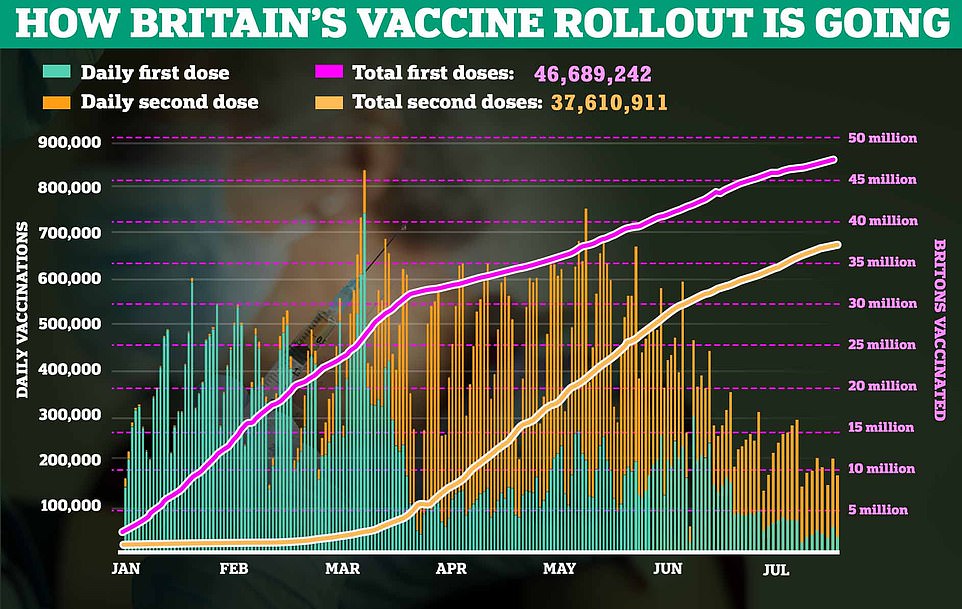
Britain is open for business! Quarantine rules are set to be DROPPED for fully-vaccinated travellers from the EU and America as well as ex-pats who had jabs abroad
Fully-vaccinated travellers from the EU and US are set to be spared quarantine after ministers signed off an exemption today.
The powerful ‘Covid O’ group is understood to have agreed that the self-isolation requirements can be dropped for some of the UK’s major trading partners.
Ex-pats who have received jabs abroad are also set to benefit from the dispensation, which takes effect from 4am Monday.
All will still need to get tests in a bid to reduce the risk that they are infected.
Transport Secretary Grant Shapps said: ‘We’ve taken great strides on our journey to reopen international travel and today is another important step forward. Whether you are a family reuniting for the first time since the start of the pandemic or a business benefiting from increased trade – this is progress we can all enjoy.
‘We will of course continue to be guided by the latest scientific data but thanks to our world-leading domestic vaccination programme, we’re able to look to the future and start to rebuild key transatlantic routes with the US while further cementing ties with our European neighbours.’
However, there is no reciprocal arrangement with the US, which still has an almost blanket ban on Britons visiting.
Advertisement
Department of Health figures today show while hospital admissions across the UK are still rising week-on-week, their rate of growth is slowing down.
Data shows the week-on-week percentage change — which measures how quickly hospitalisations are going up — has fallen every day for a week.
It stood at 32 per cent on July 18, falling to 23.6 per cent on July 24.
Several members of SAGE, No10’s scientific advisory panel, have claimed a fall in Covid admissions would mark the beginning of the end of the third wave.
But Professor Mike Tildesley, a modeller at the University of Warwick, today said the pandemic isn’t all over ‘quite yet’, and warned the effects of ‘Freedom Day’ are still yet to be seen in the data.
Meanwhile, Boris Johnson today said it was ‘too early’ to draw conclusions about the fall in the number of people testing positive for the virus.
Separate data today revealed Scotland’s Covid hospitalisations are now falling in line with cases, raising hopes that England could soon follow suit.
Experts say one of the factors behind the drop in England is that people are no longer meeting up in large groups to watch the national team’s games in Euro 2020 tournament.
Cases rose quickest in men and young people during and following the tournament but began to drop in Scotland around eight days after the team were knocked out in the group stages by Croatia.
And likewise, England’s declining cases began on July 19 — eight days after the Three Lions lost on penalties in an historic final against Italy.
Professor Paul Hunter, an infectious disease expert at the University of East Anglia, claimed it was ‘reasonable’ to expect England to follow a similar timescale to Scotland in terms of its fall in admissions as well — which would see hospitalisations drop by the end of the week.
He told MailOnline that while England may not see admissions fall on the ‘exact same day’ after their Euros exit as Scotland did, hospitalisations have already begun slowing.
Professor Hunter said: ‘I think it reasonable to assume that sometime in the next few days we may start to see a fall in new hospitalisations, maybe not the exact same day [as Scotland did after the Euros].
‘In fact if you look at the rate of increase in England admissions, it does look like the epidemic of admissions is slowing.
‘Data on hospital admissions are often somewhat delayed before publication and Scotland’s especially can be delayed for almost a full week.
‘Of course whether such a fall is sustained after the effect of Freedom Day works its way into the system is still the big question. We will know at the weekend.’
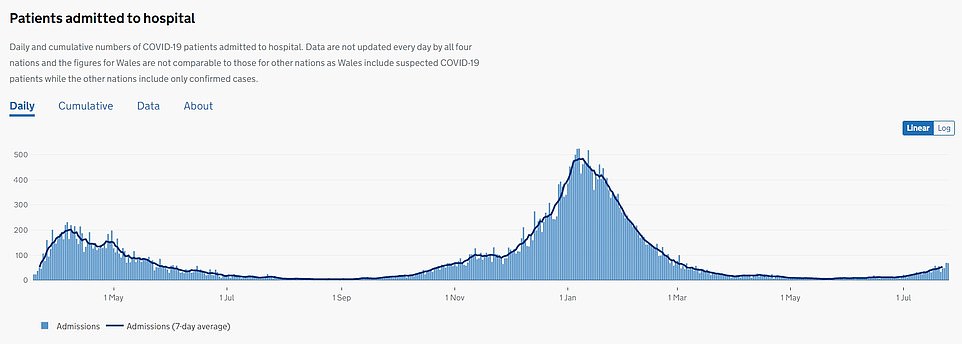
EAST OF ENGLAND: Hospital admissions are still rising in the East of England but at a slow rate as of the most recent data

LONDON: Admissions in London were at 130 on July 25, down from 141 three days before as hospitalisations start to round off in the capital
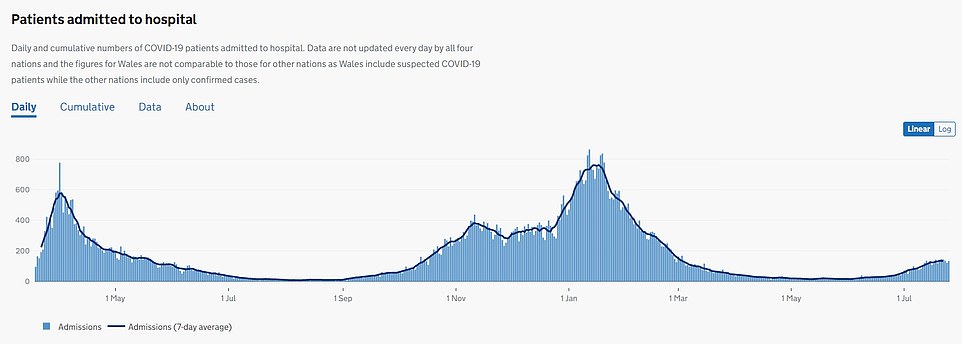
MIDLANDS: Hospitalisations are also starting to round off in the Midlands, down to 133 on July 25 compared to 146 on July 21

NORTH EAST AND YORKSHIRE: The North East and Yorkshire has seen one of the highest upticks in admissions this summer and hospitalisations appear to be continuing to rise

NORTH WEST: Admissions are relatively flat in the North West, with 123 patients admitted on July 25 compared to 151 on July 19

SOUTH EAST: Hospitalisations are still rising but at a slow rate in the South East, which recorded 79 admissions on July 25

SOUTH WEST: Admissions did appear to be falling in the South West other than an on July 25 — the most recent date data goes up to— when there were 83 hospitalisations
Covid cases are now falling in EVERY age group in England: Experts hail promising infection data
Coronavirus cases are now falling across all age groups, according to official data which boosts hopes that the end of England’s third wave may now be in sight.
Top scientists advising the Government warned it was ‘almost inevitable’ daily infections would spiral to 100,000 next month, with one even warning they could reach double this figure.
But in an unexpected twist which has puzzled scientists, cases have actually fallen every day for the past week — with yesterday’s count being just half of what it was a week ago.
Department of Health data today revealed that infection rates are now ticking downwards in every age group in England, dipping fastest among twenty-somethings.
Experts said the downturn in cases was a ‘very good’ sign because it adds to mounting evidence that the third wave is in retreat. But they cautioned more data was needed before they could be certain the drop is permanent, and cases won’t tick up again following July 19 ‘Freedom Day’.
Dr Jonathan Stoye, a virologist at the Francis Crick Institute, said the drop in Covid cases in all age groups was ‘very good’.
He told MailOnline: ‘But the key thing will be to wait until Friday when we will get the next round of results from the ONS (Britain’s largest Covid surveillance study).
‘One would predict it may be less sensitive to changes in the populations being tested, for example those resulting from school closures, than the Department of Health figures.
‘If the two measures are going in the same direction we would seem to be in a good place… unless, of course, the unlocking of July 19 causes a reversal.’
Department of Health data showed Covid cases were falling fastest among adults in their twenties last week, down by 15 per cent for the week ending July 22 compared to the day before.
But among older adults the decline was more gradual, suggesting cases were only just starting to drop in the age group. Infection rates dropped by just one per cent in adults in their late 80s.
Advertisement
Scotland’s Covid admissions — based on the seven-day average — began falling on July 10, when they peaked at 87 per day.
It occurred a full 18 days after the national team left the Euros on June 22 and ten days after infections started to fall.
The country’s cases peaked at almost 4,000 on June 30. Government data also shows.
England’s cases have already followed the same trend, with the number of positive tests declining after the national team lost in the Euros.
If the country’s admissions follow the same trend, they would be likely to peak by the end of the week.
Despite being on the rise with more than 800 infected people still needing hospital treatment every day, Covid admissions already appear to be slowing down across England.
Admission growth rates in England went from 37.9 per cent on June 15 to 23.1 per cent on June 22.
Only the North East and Yorkshire — the country’s current Covid hotspot — still has admissions that are rising at pace.
Questions remain as to whether the current decline in cases will continue or if they will tick up again once testing increases after people have been on their summer holidays, the weather takes a turn and children return to the classrooms in September.
But experts say a fall in admissions could be the clearest sign yet that the third wave is beginning to end and was not as big as was expected.
SAGE models released a week before ‘Freedom Day’ predicted infections could reach as high as 200,000 in a worst case scenario.
Speaking on Times Radio this morning, Professor Tildesley said: ‘Because schools in England closed last week, we haven’t got secondary school pupils doing regular lateral flow testing and so we’re not necessarily detecting as many cases in younger people.
‘It’s also been suggested by some that, possibly, because of a high number of cases, because of the summer holidays approaching, people might be less willing to ‘step up’ to testing when they have symptoms.
‘What we really need to do is monitor hospital admissions, because at the moment of course they’re still going up – now, of course there is a lag when cases go down, it always takes a couple of weeks before hospital admissions turn around.
‘But if we start to see as we get into August, if we start to see hospital admissions going down as well then I think we would have much stronger evidence to suggest that this third wave is starting to turn around.’
And yesterday Professor Graham Medley, chair of SAGE’s modelling group Spi-M, told MailOnline: ‘The current fall in cases is a bit puzzling, so there probably isn’t a simple explanation.
‘If infections were falling because of immunity, then it would not happen everywhere at the same time.
‘The only thing that happened everywhere in England at the same time was the football. We have also been vaccinating younger people in the past few weeks, and vaccination takes some time to develop immunity.
‘There is a changing in testing behaviour — although the number of positive tests has fallen, the proportion of tests that are positive has remained quite high.
He added: ‘The ‘pingdemic’ meant a lot of people isolating, and you can’t get infected if you are isolating so a side effect of the ‘pingdemic’ might be to reduce infection rates.
‘We will see in the coming days if hospital admissions start to fall. If they do, then it does suggest that we have got over this wave, which turned out to be quite small.
‘This doesn’t mean that we will not see more waves, but it is very encouraging.’
Source link : https://www.dailymail.co.uk/news/article-9839043/Cases-NOT-falling-fast-official-figures-suggest-symptom-study-says.html











